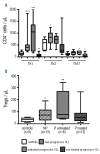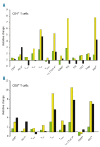T cells in chronic lymphocytic leukemia display dysregulated expression of immune checkpoints and activation markers
- PMID: 27927767
- PMCID: PMC5394965
- DOI: 10.3324/haematol.2016.151100
T cells in chronic lymphocytic leukemia display dysregulated expression of immune checkpoints and activation markers
Abstract
Chronic lymphocytic leukemia is characterized by impaired immune functions largely due to profound T-cell defects. T-cell functions also depend on co-signaling receptors, inhibitory or stimulatory, known as immune checkpoints, including cytotoxic T-lymphocyte-associated antigen-4 (CTLA-4) and programmed death-1 (PD-1). Here we analyzed the T-cell phenotype focusing on immune checkpoints and activation markers in chronic lymphocytic leukemia patients (n=80) with different clinical characteristics and compared them to healthy controls. In general, patients had higher absolute numbers of CD3+ cells and the CD8+ subset was particularly expanded in previously treated patients. Progressive patients had higher numbers of CD4+ and CD8+ cells expressing PD-1 compared to healthy controls, which was more pronounced in previously treated patients (P=0.0003 and P=0.001, respectively). A significant increase in antigen-experienced T cells was observed in patients within both the CD4+ and CD8+ subsets, with a significantly higher PD-1 expression. Higher numbers of CD4+ and CD8+ cells with intracellular CTLA-4 were observed in patients, as well as high numbers of proliferating (Ki67+) and activated (CD69+) CD4+ and CD8+ cells, more pronounced in patients with active disease. The numbers of Th1, Th2, Th17 and regulatory T cells were substantially increased in patients compared to controls (P<0.05), albeit decreasing to low levels in pre-treated patients. In conclusion, chronic lymphocytic leukemia T cells display increased expression of immune checkpoints, abnormal subset distribution, and a higher proportion of proliferating cells compared to healthy T cells. Disease activity and previous treatment shape the T-cell profile of chronic lymphocytic leukemia patients in different ways.
Copyright© Ferrata Storti Foundation.
Figures






References
-
- D’Arena G, Laurenti L, Minervini MM, et al. Regulatory T-cell number is increased in chronic lymphocytic leukemia patients and correlates with progressive disease. Leuk Res. 2011;35(3):363–368. - PubMed
-
- Dasgupta A, Mahapatra M, Saxena R. A study for proposal of use of regulatory T cells as a prognostic marker and establishing an optimal threshold level for their expression in chronic lymphocytic leukemia. Leuk Lymphoma. 2015;56(6):1831–1838. - PubMed
Publication types
MeSH terms
Substances
LinkOut - more resources
Full Text Sources
Other Literature Sources
Research Materials

